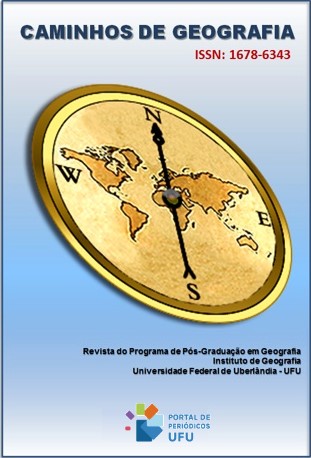THE SOIL IN GEOGRAPHY TEACHING: STATE OF KNOWLEDGE, PERSPECTIVES AND CHALLENGES
DOI:
https://doi.org/10.14393/RCG249466081Keywords:
School Geography, Approaches to soil, Physical-natural componentsAbstract
This paper analyzes the approaches about the natural-physical components of geographic space, with emphasis on soil, in researches developed in the field of Physical Geography and Geography Teaching. For this purpose, two significant events from each of these areas were selected, in editions carried out uninterruptedly, in a time span of 10 years. In the first case, the survey was carried out at SINAGEO and SBGFA; and as representatives of the second, the ENPEG and NEPEG Forum, for understanding that these events are configured as one of the main platforms for the dissemination and discussion of research in both areas of Brazilian Geography. Mobilizing the State of knowledge and Content Analysis, in the methodology, we counted and analyzed the texts that deal with the teaching of soil in the context of physical-natural components. The analyses indicated that the soil has not assumed a protagonist role; that the events of Physical Geography have been the platform preferentially chosen by the authors to disseminate their contributions; and that there is still a paradigm favoring fragmented and dichotomous interpretations in the approaches about the soil, especially in the researches conducted by one of the strands of Environmental Education, the preservationist perspective.
Downloads
Downloads
Published
How to Cite
Issue
Section
License
Copyright (c) 2023 Samuel de Oliveira Mendes, Kassio Samay Ribeiro Tavares, Eliana Marta Barbosa de Morais

This work is licensed under a Creative Commons Attribution-NonCommercial-NoDerivatives 4.0 International License.
Autores que publicam nesta revista concordam com os seguintes termos: a) Autores mantém os direitos autorais e concedem à revista o direito de primeira publicação, com o trabalho licenciado sob a Creative Commons Atribuição-NãoComercial-SemDerivações 4.0 Internacional. b) Autores têm permissão e são estimulados a publicar e distribuir seu trabalho online (ex.: em repositórios institucionais ou na sua página pessoal), já que isso pode gerar alterações produtivas, bem como aumentar o impacto e a citação do trabalho publicado. c) Em virtude de aparecerem nesta revista de acesso público, os artigos são de uso gratuito, com atribuições próprias, em aplicações educacionais e não-comerciais.











